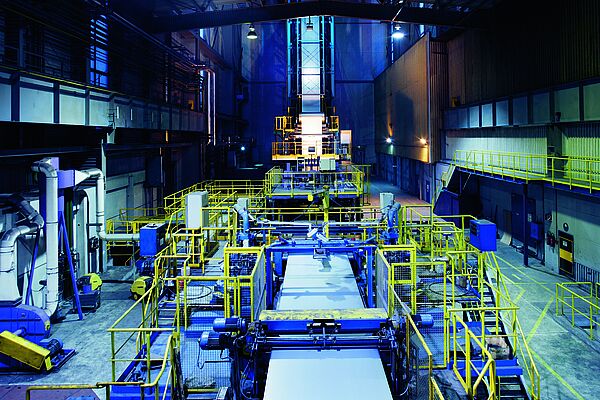Optimisation of the cooling process for steel strip
In the steel industry, optimal cooling of steel strips is essential for product quality.
Scientists Martin Niederer and Andreas Kugi from the AIT Austrian Institute of Technology, together with their colleagues Paul Zeman, Gerald Helekal and Hannes Seyrkammer from voestalpine Stahl GmbH and Solveig Sannes and Andreas Steinboeck from the Vienna University of Technology, have developed a new real-time capable mathematical model. This model describes the temporal and spatial evolution of temperature and phase fractions in a steel strip during cooling. The model was published in the International Journal of Heat and Mass Transfer under the title "A control-oriented mathematical model for the evolution of temperatures and phases in a steel strip during cooling". The objective is accurately predict phase transformations and temperature trajectories and, in combination with modern control concepts, to improve product quality.
Summary of the research results
The publication presents a new dynamic state-space model that is new compared to the state of the art in the process automation of steel strips. It accurately describes the local and temporal evolution of the temperature and the phase fractions in a steel strip during the cooling process in real time. One research focus was on the description of phase transformations, i.e., the decomposition of austenite into the phases ferrite, bainite and martensite. The model takes into account the coupling between the phase transformations and the temperature evolution of the steel strip and includes the main heat transfer mechanisms convection and radiation. It is mainly characterised by a good trade-off between accuracy and computational effort, making it particularly attractive for real-time optimisation, control and monitoring in an industrial environment.
The capability and accuracy of the model have been demonstrated by comprehensive comparisons of simulation results with measurement data from both experimental material tests and from the ongoing operation of the real industrial plant.
Significance and outlook
In modern steel production, the temperature evolution of steel strips during cooling is crucial for product quality. It influences the formation of different phases, which are decisive for the material properties and thus for the final product quality of the steel product. The steel products are used in a wide range of applications, for example in the automotive industry. The real-time capable model presented can be used to describe the evolution of both the temperature and the phase fractions during cooling. It thus enables improved product quality by more precise temperature tracking using modern control methods and provides a solid basis for further research work on the feedback control of phase fractions.
Through the co-operation with voestalpine Stahl GmbH and the Vienna University of Technology, AIT was able to make an important contribution to improve industrial heat treatment processes in steel production.
We congratulate the authors Martin Niederer and Andreas Kugi and their colleagues at voestalpine Stahl GmbH and the Vienna University of Technology on this great success and look forward to further developments in this exciting field of research.
M. Niederer, P. Zeman, S. Sannes, H. Seyrkammer, G. Helekal, A. Kugi, A. Steinboeck, A control-oriented mathematical model for the evolution of temperatures and phases in a steel strip during cooling, International Journal of Heat and Mass Transfer, Volume 225, 2024, 125365, https://doi.org/10.1016/j.ijheatmasstransfer.2024.125365.



